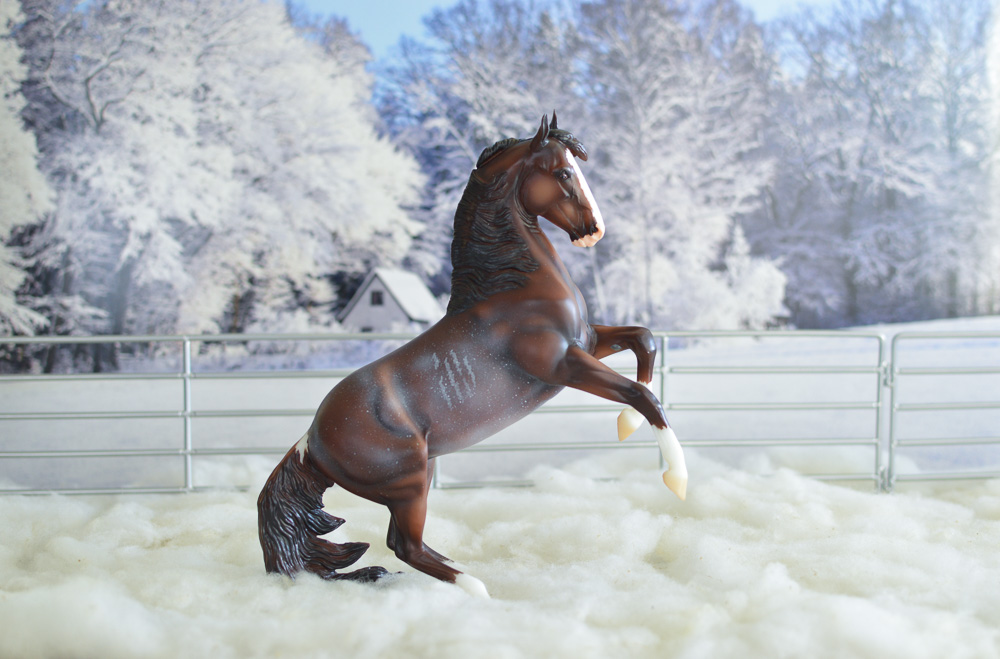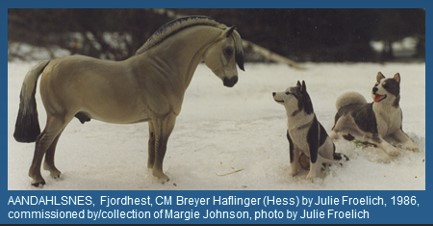My reentry in the hobby has corresponded with the decline of my parents, work/studies/home transitions, and lack of a good place to set up for painting previously and now, mid-reno stretching from before the pandemic. So, I have been largely prepping, with a piece in an early paint layer and a few in gesso — I have quite a stash to work on. I do my own CM/finish work on plastic and AR and will show halter only; my model work is for myself/gifting/donating until downsizing. Besides the art/research rabbit holes, what I love about the hobby is how it lets you explore many more horse breeds/cultures/disciplines than real life would allow, and nowadays, the hobby boasts more new product than anyone could amass.
My showing goals are largely social, with the benefits of: a) seeing prominent work/collections in person, and b) seeing what I think of my work’s plusses and minuses in the show ring. I’ve visited shows, judged a bit, and shown some vintage work over the past 20 years; I’m lucky to be in a highly competitive region with more shows geographically accessible than average in a smaller area — it also generally aligns with my taste in models grounded in realism. I haven’t had enclosed shelves/display set up, so shows are always a day to spend with my horses. I volunteered at a regional NAN, and the introduction of NAN buy-ins (one can’t assume cards in RX) make a Breyerfest week of showing (NAN, Resin Renaissance, and the Stone show) a notion, maybe for 2028. My travel budget focused more on seeing real horses 2010-2017, that roving convention has moved online since 2020.
On questions 8/9, I believe we leave a lot of potential growth and participation out in the aether by not offering a third silo for artisan classes, an Entrant Work/DIY slate of classes in addition to those for Open Breed and Open Workmanship, with participants in Entrant Work eligible to enter all three silos if desired/qualified per venue structure. My full pitch for this details a limited-materials-list CM (hand-painted acrylics as a common entry medium) for different costs/sizes of plastic models that scaffolds scale/budget levels without defining people/skills (see below). Open classes stand as their own thing, as collection showing has long been inclusively codified in the hobby, drives many art businesses, and many artists prize having national and international competition on the table with them. As the only format available, showing your own work in a piece-only class (vs. diorama/performance) against collected work is unusual in art hobbies and competitive exhibition. We’d likely have more participants at all levels if we had artisan classes dedicated to showing your own handiwork against same in addition to the open classes, which may or may not have a similar playing field depending on show attendance/class participation by established studios — the question is who did the finishwork, entrant or other. The intention is to include a broader range of entry points for model horse artists in a format that makes sense to other art hobbyists.
I’ll be holding debut CM/AR schooling shows (10 participants show and judge others’ pieces) with this sample format (two days Breed/Workmanship), and could recycle the classes into a one-day show with two or more judges. It can be pushed and pulled into various shapes tailored to needs, for example, breed group breakouts for the youth/intermediate-friendly Limited Materials categories. The main twist for this simpler debut format is a total split between Entrant and Collection pieces, and groupings of classes up four at a time for table circulation and theme. A long form of possible classes Breed/Type sorted by degrees of work performed on CM/AR pieces in various scales would be for a much larger and granular venue like NAN.
BREED: LIGHT (one section for sample): • CM finish by Entrant, LIGHT Breeds/Types; • CM from Collection, LIGHT Breeds/Types; • AR finish by Entrant, LIGHT Breeds/Types; • AR from Collection, LIGHT Breeds/Types.
WORKMANSHIP: DECORATIVE FINISH, MODEL EQUINE/EQUID/FANTASY (NAMHSA) (1:12 scale and larger): • CM finish by Entrant; • CM from Collection; • AR finish by Entrant; • AR from Collection.
WORKMANSHIP: FANTASY FINISH, NAMHSA-RULES FANTASY MODEL EQUINE/EQUID (1:12 scale and larger): • CM finish by Entrant; • CM from Collection; • AR finish by Entrant; • AR from Collection.
WORKMANSHIP: AR MICRO-MINI SCALES CHALLENGE (ENTER UP TO 3 PER CLASS) • AR finish by Entrant, MICRO-MINI Model Equine/Equid, ALL REALISTIC COLORS; • AR from Collection, MICRO-MINI Model Equine/Equid, ALL REALISTIC COLORS; • AR finish by Entrant, MICRO-MINI Model Equine/Equid/Fantasy (NAMHSA rules), FANTASY/DECORATIVE; • AR from Collection, MICRO-MINI Model Equine/Equid/Fantasy (NAMHSA rules), FANTASY/DECORATIVE.
WORKMANSHIP: MINI-SCALES MODEL EQUINE/EQUID (all typical scales up to 1:12 scale, adults to ~4" at ears ); ALL MEDALLIONS, BUSTS, BAS RELIEFS (EQUINE/EQUID, all partial forms, realistic except fantasy/deco classes) • Black/Bay/Brown (one section for sample color group): • CM/AR finish by Entrant, ALL MINI-SCALES Model Equine/Equid, BLACK/BAY/BROWN; • CM/AR from Collection, ALL MINI-SCALES Model Equine/Equid, BLACK/BAY/BROWN; • AR finish by Entrant, MEDALLIONS ETC. Equine/Equid, BLACK/BAY/BROWN; • AR from Collection, MEDALLIONS ETC. Equine/Equid, BLACK/BAY/BROWN.
CM LIMITED MATERIALS AWE (All Work Entrant, on rigid or flexible plastic retail 3D horse ~1:32 to ~1:6 scale): • CM Limited Materials, Realistic, All Work Entrant, playset plastic (Schleich, CollectA, etc.) scales below 1:12; • CM Limited Materials, Realistic, AWE Venti Painted-Details Challenge, WIA/CollectA (~1:20); • CM Limited Materials, Realistic, All Work Entrant, rigid plastic (Breyer, Stone, etc.) scales below 1:12; • CM Limited Materials, Realistic, All Work Entrant, rigid plastic (Breyer, Stone, etc.) 1:12 scale and larger.




I like the morphology approach of Lesli’s list very much, as it relates common sources and appearances beyond geography. I am not showing new pieces yet, but while I think of them as a diverse collection, I have heavier Arabian, Old World Spanish, and draft horse contingents, which are always well-represented classes/groups in CM and AR. Familiar with my region’s scope, I’ll be re-entering mostly socially to see how my work looks on the table to me in company.